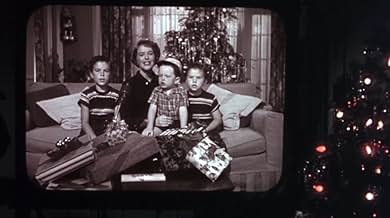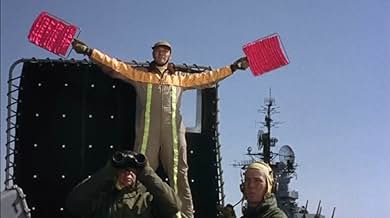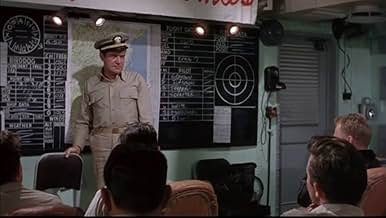Ann Baker
- Mary, Schechter's Fiancee
- (uncredited)
Jack Boyle Jr.
- Officer
- (uncredited)
Jonathan Hale
- Home Movie Commentator
- (uncredited)
Teddy Infuhr
- Andy Szymanski Jr.
- (uncredited)
Ronald Lisa
- Replacement
- (uncredited)
Jerry Mathers
- Richard Dodson
- (uncredited)
Steve Mitchell
- Soldier
- (uncredited)
- Director
- Writers
- All cast & crew
- Production, box office & more at IMDbPro
Featured reviews
A thirty-ish Van Johnson as Lt. Howard Thayer is excellent in his talk-talk scenes with the blinded pilot, his friend Ken. Johnson's character is confined in the fighter pilot's seat, encased in flight gear and helmet, with the actor having only his voice and facial expressions to convey his depth of concern. The flying sequences have been very positively reviewed by veterans on a fighter pilots information sharing website, Korean War veterans sharing website, and military movie catalog website; always noted to be realistic. Actors dialog in the talk-down scene was transcribed from the actual pilots radio transmissions, with very few exceptions (actual is posted online). Bombing scenes are actual, but not graphic compared to modern special effects scenes. Should not be disturbing to younger viewers. Not a celebration of war, this film deals with loss of pilots lives, it's effect on friends and family. Touching but not soapy or sorrowful. The film has variety of action, and keeps moving along well. Noted to be the best Korean War action film, and Carrier film ever produced.
One look at the opening of this movie lets you know thta is not the work of MGM boss Louis B Mayer but his replacement Dore Schary whose job was to cut costs and make profits which MGM had stopped doing, leading in grosses but last in profits. Schary brought his penchant for reality with him starting with Battleground and once more here again. The star of the first is the star of the latter and by that I mean Van Johnson. This movie is about the Korean war which in the movie is referred to as a police action because an official war was never declared. True story taken from the Saturday Evening Post tells the tale of bomber planes on a Naval tanker during the war. It is very matter of fact with little plot but the lives of the men and their difficulty destroying a rail track that just seems to get rebuilt every time. Walter Pidgeon provides good support as the commander and everyone else is just fine and a thirty minute rescue scene is so impressive, it makes you wonder if this people had not been watching the Europen movies; the droll delivery, the spacial pacing, the voice over that is a third character, the actual footage of attacks because any attack or firing is actual footage. Fine movie all around that needs to be seen by more.
MEN OF THE FIGHTING LADY is a very unglamorous, but very gritty Korean War aircraft carrier picture whose centerpiece--the episode of a jet fighter pilot blinded by gunfire and "talked" back to a safe landing--is a true account from a story by Harry A. Burns titled "The Case of the Blind Pilot." The secondary script source for the story line is author James Michener (TALES OF THE SOUTH SEAS, HAWAII, THE SOURCE) who is actually portrayed in the film by Louis Calhern.
The lives of jet fighter pilots aboard the Fighting Lady in the Sea of Japan and their treacherous missions to destroy key North Korean military installations serve as the exposition for this slice-of-life, often neglected chapter in American war history. The mood and atmosphere of the film contain an unmistakable Korean War grimness that clouds over the men from beginning to end as they cut through the harsh North Korean skies battling ceaseless anti-aircraft fire in mission after mission.
MEN OF THE FIGHTING LADY is unromantic and raw. It's theme is the harsh, day-to-day experience of jet pilots who flew their missions under the gloom of being shot out of the air. For it is well worth remembering that unlike Viet Nam and subsequent Iraq wars, Korean War bombing missions exposed pilots to blistering anti-aircraft fire and attacking enemy aircraft resulting in numerous pilot casualties and downed planes. Not to be forgotten is that the Korean War was the first, full-blown "jet aircraft war" in history.
The opening of the film begins with a nostalgic flashback over "ham and eggs" recalled by Louie Calhern who recalls the episodes aboard the Fighting Lady and the lives of heroic pilots during the Korean War conflict. The lives of the men and their interaction with their commanders lead to the film's signal sequence in which Ensign Kenneth Schecter (Dewey Martin) is strafed by enemy fire in his cockpit while on a mission and radios back that he is blind. Lt Thayer (Van Johnson) calms him and ultimately talks him back to a perfect landing aboard the Fighting Lady. In another moving scene at Christmas, the entire squadron watches movie footage of a pilot's wife sending her love to her husband---who had just lost his life on a mission.
Frank Lovejoy and Walter Pigeon are perfect fits as salty naval officers bearing up under the harsh war conditions in the Sea of Japan at that time. Former MGM musical comedy star Van Johnson is excellent as Lt. Thayer guiding the sightless ensign back in safely to the carrier deck. A young Kennan Wynn portrays the anxiety of a flight deck signalman very effectively.
There may have been better Korean War films--BRIDGES AT TOKO-RI, PORK CHOP HILL, RETREAT, HELL, but many of those fine films are packaged within romantic portrayals of war. MEN OF THE FIGHTING LADY has no romantic sub-plot, no love story, and, in short, no women. The film is superior in its depiction of the reality of a jet pilot's life walking the thin line between returning from a mission in one piece and facing annihilation. MEN OF THE FIGHTING LADY also contains effective and very real stock footage of jet take-offs and landings as well as North Korean targets under actual cannon fire from American sorties.
MEN OF THE FIGHTING LADY should be viewed by anyone interested in the true mood and atmosphere of the Korean War years when a jet pilot faced demise on every mission--and for the time in our nation's history when Starfighters and Scorpian jets ruled the skies over the Sea of Japan.
Trivia: MEN OF THE FIGHTING LADY should not be confused with the 1944 release THE FIGHTING LADY starring Charles Boyer and Robert Taylor. That film follows the exploits of the USS Yorktown.
Dennis Caracciolo
The lives of jet fighter pilots aboard the Fighting Lady in the Sea of Japan and their treacherous missions to destroy key North Korean military installations serve as the exposition for this slice-of-life, often neglected chapter in American war history. The mood and atmosphere of the film contain an unmistakable Korean War grimness that clouds over the men from beginning to end as they cut through the harsh North Korean skies battling ceaseless anti-aircraft fire in mission after mission.
MEN OF THE FIGHTING LADY is unromantic and raw. It's theme is the harsh, day-to-day experience of jet pilots who flew their missions under the gloom of being shot out of the air. For it is well worth remembering that unlike Viet Nam and subsequent Iraq wars, Korean War bombing missions exposed pilots to blistering anti-aircraft fire and attacking enemy aircraft resulting in numerous pilot casualties and downed planes. Not to be forgotten is that the Korean War was the first, full-blown "jet aircraft war" in history.
The opening of the film begins with a nostalgic flashback over "ham and eggs" recalled by Louie Calhern who recalls the episodes aboard the Fighting Lady and the lives of heroic pilots during the Korean War conflict. The lives of the men and their interaction with their commanders lead to the film's signal sequence in which Ensign Kenneth Schecter (Dewey Martin) is strafed by enemy fire in his cockpit while on a mission and radios back that he is blind. Lt Thayer (Van Johnson) calms him and ultimately talks him back to a perfect landing aboard the Fighting Lady. In another moving scene at Christmas, the entire squadron watches movie footage of a pilot's wife sending her love to her husband---who had just lost his life on a mission.
Frank Lovejoy and Walter Pigeon are perfect fits as salty naval officers bearing up under the harsh war conditions in the Sea of Japan at that time. Former MGM musical comedy star Van Johnson is excellent as Lt. Thayer guiding the sightless ensign back in safely to the carrier deck. A young Kennan Wynn portrays the anxiety of a flight deck signalman very effectively.
There may have been better Korean War films--BRIDGES AT TOKO-RI, PORK CHOP HILL, RETREAT, HELL, but many of those fine films are packaged within romantic portrayals of war. MEN OF THE FIGHTING LADY has no romantic sub-plot, no love story, and, in short, no women. The film is superior in its depiction of the reality of a jet pilot's life walking the thin line between returning from a mission in one piece and facing annihilation. MEN OF THE FIGHTING LADY also contains effective and very real stock footage of jet take-offs and landings as well as North Korean targets under actual cannon fire from American sorties.
MEN OF THE FIGHTING LADY should be viewed by anyone interested in the true mood and atmosphere of the Korean War years when a jet pilot faced demise on every mission--and for the time in our nation's history when Starfighters and Scorpian jets ruled the skies over the Sea of Japan.
Trivia: MEN OF THE FIGHTING LADY should not be confused with the 1944 release THE FIGHTING LADY starring Charles Boyer and Robert Taylor. That film follows the exploits of the USS Yorktown.
Dennis Caracciolo
Author James A. Michener visits the aircraft carrier USS Oriskany during the Korean War. He is tasked to write the crew's Christmas story. He is brought to flight surgeon Kent Dowling who recounts the story.
Released a year after the war, this is adapted from a magazine story by Michener. The use of the real thing and some real footage helps heighten the intensity. Seeing the real thing is fascinating even all these years later. Seeing the real bombing runs must have been compelling back in the day. I do remember the plane explosive crash on the carrier deck from somewhere else. I wonder if this is where it came from. Otherwise, the story is simple and the characters don't really stand out. These are good character actors and they do a solid job. As for the climatic story, it's just not that dramatic. The drama is concentrated on the landing and it's not that in doubt.
Released a year after the war, this is adapted from a magazine story by Michener. The use of the real thing and some real footage helps heighten the intensity. Seeing the real thing is fascinating even all these years later. Seeing the real bombing runs must have been compelling back in the day. I do remember the plane explosive crash on the carrier deck from somewhere else. I wonder if this is where it came from. Otherwise, the story is simple and the characters don't really stand out. These are good character actors and they do a solid job. As for the climatic story, it's just not that dramatic. The drama is concentrated on the landing and it's not that in doubt.
Surprisingly enough, most of the action scenes were from real wartime footage which is incorporated very well, its reality adds to the suspense instead of subtracting. The fact that James Michener is one of the characters makes it more interesting, but there's just too much talk about bravery and duty to make this film really shine. Well worth watching, good stars, but not above the routine.
Did you know
- TriviaF9F Panther jets from US Navy squadron VF-192 were also used to film Les ponts de Toko-Ri (1954). After the filming of these two movies, the squadron name was changed from "Golden Dragons" to "World Famous Golden Dragons".
- GoofsDuring the emergency landing sequence, when the plane is shown landing and being stopped by the barrier, the nose gear collapses and the nose cone crumples. In the next shot, the plane is still in the barrier, but the nose gear is extended and the nose cone is not crumpled.
- Quotes
Comdr. Kent Dowling: [Greeting visiting author James Michener] You know, until I read your book "Tales of the South Pacific", I didn't know what a wonderful time I had in World War Two.
James A. Michener: Neither did I until Rodgers and Hammerstein set it to music.
Comdr. Kent Dowling: Why didn't you stop while you were ahead? Even Shakespeare couldn't make this dirty little war romantic.
- ConnectionsFeatured in La bataille de Midway (1976)
Details
Box office
- Budget
- $829,000 (estimated)
- Runtime1 hour 19 minutes
- Aspect ratio
- 1.75 : 1
Contribute to this page
Suggest an edit or add missing content


































